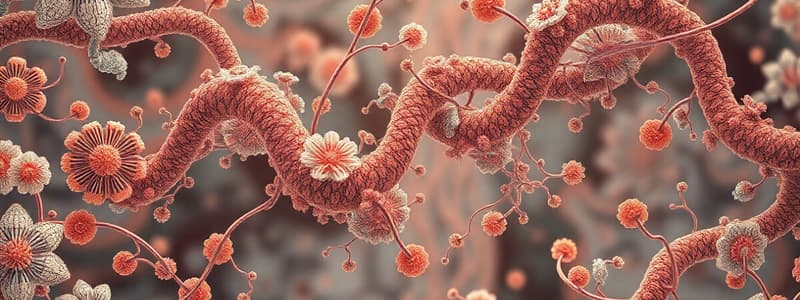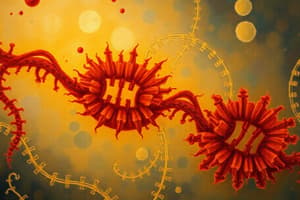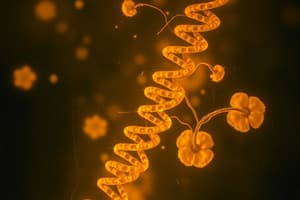Podcast
Questions and Answers
Why is the control of gene expression important in prokaryotes?
Why is the control of gene expression important in prokaryotes?
The control of gene expression is important in prokaryotes because it allows them to respond quickly to changes in their environment by producing only the proteins they need when they need them. This saves energy and resources.
Which of the following is NOT a level of gene expression regulation in eukaryotes?
Which of the following is NOT a level of gene expression regulation in eukaryotes?
- Remodeling of chromatin
- Transcriptional control
- Operon regulation (correct)
- Alternative splicing
Prokaryotes utilize more points of control for gene expression than eukaryotes.
Prokaryotes utilize more points of control for gene expression than eukaryotes.
False (B)
What is the name of the structural unit of transcriptional regulation in prokaryotes?
What is the name of the structural unit of transcriptional regulation in prokaryotes?
What is the role of the operator in an operon?
What is the role of the operator in an operon?
What is the primary function of the lac operon in E. coli?
What is the primary function of the lac operon in E. coli?
What type of regulation does the lac operon exhibit?
What type of regulation does the lac operon exhibit?
What is the role of the inducer in an inducible operon?
What is the role of the inducer in an inducible operon?
What is the role of the co-repressor in a repressible operon?
What is the role of the co-repressor in a repressible operon?
What is the name of the activator protein that acts on the lac operon in E. Coli?
What is the name of the activator protein that acts on the lac operon in E. Coli?
The trp operon is an example of an inducible operon.
The trp operon is an example of an inducible operon.
What is the role of sigma factors in prokaryotes?
What is the role of sigma factors in prokaryotes?
What is the name of the common regulatory sequence found in the promoter of many eukaryotic genes?
What is the name of the common regulatory sequence found in the promoter of many eukaryotic genes?
What is the role of transcription factors in eukaryotic gene expression?
What is the role of transcription factors in eukaryotic gene expression?
Which of the following is NOT a general transcription factor?
Which of the following is NOT a general transcription factor?
What is the function of enhancers?
What is the function of enhancers?
What is the role of the mediator complex in eukaryotic gene expression?
What is the role of the mediator complex in eukaryotic gene expression?
What is a common structural motif found in transcription factors that enables them to bind DNA?
What is a common structural motif found in transcription factors that enables them to bind DNA?
Alternative splicing can result in the production of multiple proteins from a single gene.
Alternative splicing can result in the production of multiple proteins from a single gene.
What is the primary function of microRNAs (miRNAs)?
What is the primary function of microRNAs (miRNAs)?
What is the primary function of small interfering RNAs (siRNAs)?
What is the primary function of small interfering RNAs (siRNAs)?
How is protein longevity regulated in cells?
How is protein longevity regulated in cells?
Epigenetic changes are always permanent and irreversible.
Epigenetic changes are always permanent and irreversible.
What are two major epigenetic mechanisms that can regulate gene expression?
What are two major epigenetic mechanisms that can regulate gene expression?
DNA methylation typically occurs at CpG islands, which are regions of DNA with high concentrations of cytosine and guanine nucleotides.
DNA methylation typically occurs at CpG islands, which are regions of DNA with high concentrations of cytosine and guanine nucleotides.
Explain the role of histone acetylation in gene regulation.
Explain the role of histone acetylation in gene regulation.
Chromatin remodeling involves changes in the DNA sequence of a gene.
Chromatin remodeling involves changes in the DNA sequence of a gene.
Flashcards
Transcriptional Regulation of Gene Expression
Transcriptional Regulation of Gene Expression
The process of regulating gene expression in a cell by controlling the rate of transcription of DNA into RNA.
Operons
Operons
Clusters of genes in prokaryotes that share a single promoter and are transcribed together.
Repressor Protein
Repressor Protein
A protein that binds to the operator region of an operon and prevents transcription of the genes.
Induction
Induction
Signup and view all the flashcards
Inducer
Inducer
Signup and view all the flashcards
Inducible Operon
Inducible Operon
Signup and view all the flashcards
Repressible Operon
Repressible Operon
Signup and view all the flashcards
Co-repressor
Co-repressor
Signup and view all the flashcards
Lac operon
Lac operon
Signup and view all the flashcards
Trp operon
Trp operon
Signup and view all the flashcards
Activator Protein
Activator Protein
Signup and view all the flashcards
Sigma Factor
Sigma Factor
Signup and view all the flashcards
Enhancer
Enhancer
Signup and view all the flashcards
Silencer
Silencer
Signup and view all the flashcards
Mediator
Mediator
Signup and view all the flashcards
Helix-turn-helix Motif
Helix-turn-helix Motif
Signup and view all the flashcards
Post-Transcriptional Regulation
Post-Transcriptional Regulation
Signup and view all the flashcards
Alternative Splicing
Alternative Splicing
Signup and view all the flashcards
MicroRNAs (miRNAs)
MicroRNAs (miRNAs)
Signup and view all the flashcards
Small Interfering RNAs (siRNAs)
Small Interfering RNAs (siRNAs)
Signup and view all the flashcards
Protein Longevity
Protein Longevity
Signup and view all the flashcards
Epigenetics
Epigenetics
Signup and view all the flashcards
DNA Methylation
DNA Methylation
Signup and view all the flashcards
CpG Island
CpG Island
Signup and view all the flashcards
Histone Acetyltransferase (HAT)
Histone Acetyltransferase (HAT)
Signup and view all the flashcards
Histone Deacetylase (HDAC)
Histone Deacetylase (HDAC)
Signup and view all the flashcards
Chromatin
Chromatin
Signup and view all the flashcards
Chromatin Remodeling
Chromatin Remodeling
Signup and view all the flashcards
Transcription Factors
Transcription Factors
Signup and view all the flashcards
General Transcription Factors
General Transcription Factors
Signup and view all the flashcards
Specific Transcription Factors
Specific Transcription Factors
Signup and view all the flashcards
Promoter
Promoter
Signup and view all the flashcards
TATA Box
TATA Box
Signup and view all the flashcards
Study Notes
Gene Expression Regulation
- Gene expression is controlled at various levels in both prokaryotes and eukaryotes.
- Controlling gene expression conserves energy and allows for cellular differentiation. Prokaryotes utilize fewer control points than eukaryotes. Earlier intervention generally yields greater benefits.
Prokaryotic Gene Expression Regulation
- Prokaryotes primarily control gene expression at the transcriptional level to conserve energy.
- The control of gene expression expedites responses to environmental changes.
- Operons are units of gene expression regulation in prokaryotes, consisting of a cluster of genes with a common promoter and an operator.
- Operons typically encode enzymes or structural proteins. The genes within an operon are either all expressed or not expressed based on the availability of substrate or a metabolic product.
- Examples include inducible operons like the lac operon in E. coli, where transcription is induced by the presence of an inducer substrate (lactose) causing a repressor protein to detach from the operator site.
- Another type of operon is a repressible operon, such as the trp operon in E. coli where transcription is repressed by the presence of a co-repressor (tryptophan), causing an active repressor protein to bind to the operator site.
- Repressor and activator proteins play a role in regulating operons.
- Repressor proteins inhibit transcription by binding to the operator, preventing RNA polymerase from transcribing the genes.
- Activator proteins promote transcription by binding to specific sites on the DNA and enhancing RNA polymerase binding. This is seen when lactose is present in lac operon.
- Some operons, like lac operon, have both repressor and activator elements for heightened control.
- The lac operon plays a critical role in lactose metabolism; having enzymes to break lactose down into galactose and glucose. Allolactose (an isomer of lactose) induces the operon activation.
- lacZ gene codes for β-galactosidase, hydrolyzing lactose to glucose and galactose
- lacY gene codes for lactose permease, transporting lactose into the cell
- lacA gene codes for β-galactoside transacetylase, unclear role in lactose metabolism
- Another form of control in prokaryotes is the use of sigma factors, which bind to RNA polymerase to direct the polymerase to specific promoter sequences leading to the transcription of genes that are needed in response to environmental changes.
Eukaryotic Gene Expression Regulation
- Eukaryotes control gene expression at multiple levels after transcription.
- Eukaryotic promoters are more diverse and contain common regulatory sequences like the TATA box. General transcription factors bind to these, while specific transcription factors bind unique sequences to control gene expression in diverse cell types, stages, and under specific conditions (in response to stress, etc.).
- Enhancers and silencers, distal DNA sequences act as regulatory switches. Enhancers activate transcription and silencers repress it. They function by interacting with mediator protein complexes, influencing the basal transcription apparatus.
- Transcriptional factors possess structural motifs like helix-turn-helix that permit efficient DNA binding. This process is more complex and nuanced due to various cell types and stages.
- Post-transcriptional regulation includes alternative splicing of mRNA—creating multiple proteins from a single gene. This occurs in the nucleus.
- Other forms of post-transcriptional regulation include mRNA processing, mRNA stability, translation, and regulating protein longevity.
- MicroRNAs (miRNAs) and small interfering RNAs (siRNAs) play significant roles in regulating translation.
- Regulation of protein longevity involves the labeling of specific proteins for degradation via polyubiquitination and subsequent cleavage by the proteasome.
- Epigenetic modifications, such as DNA methylation (adding methyl groups to the cytosines within promoters), and chromatin remodeling (histone modification) control accessibility of DNA and gene regulation. Both are reversible but can be involved in stabilizing cellular phenotypes.
Studying That Suits You
Use AI to generate personalized quizzes and flashcards to suit your learning preferences.




